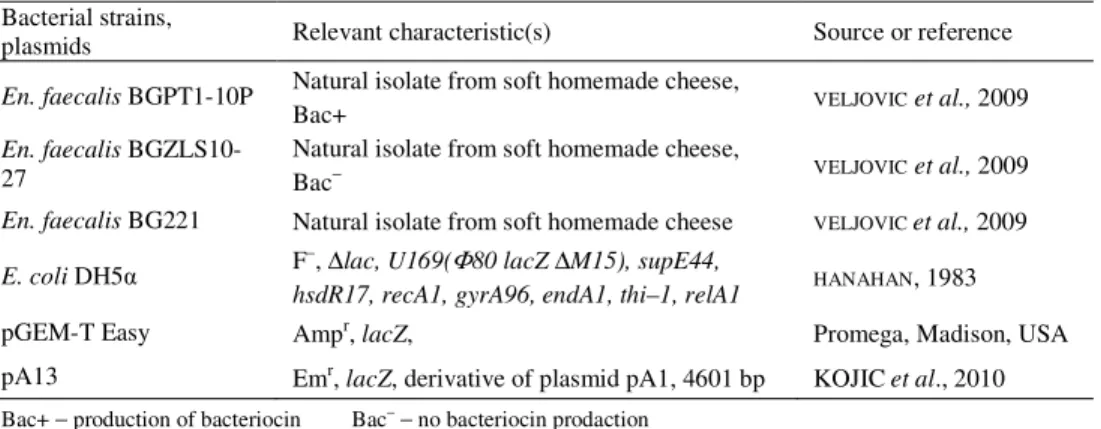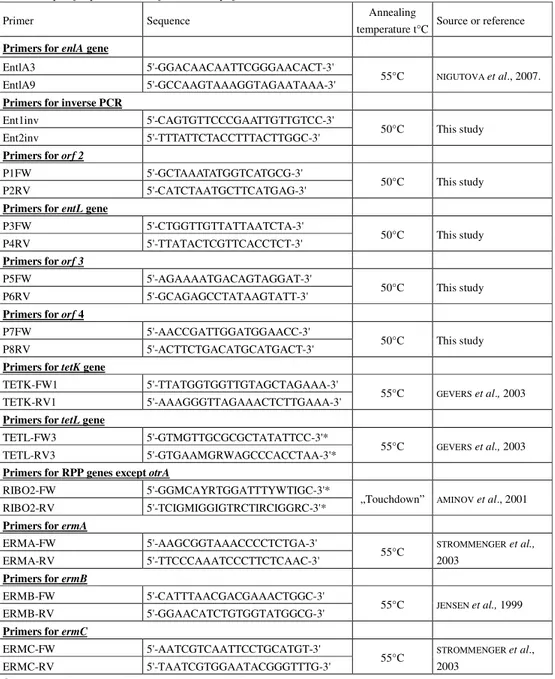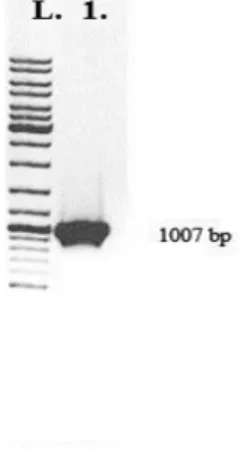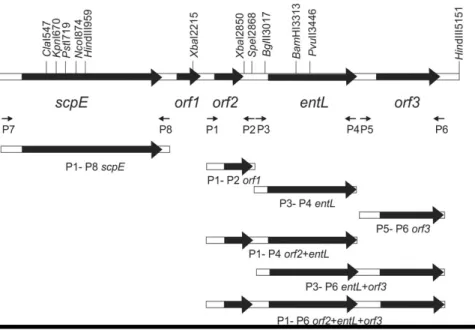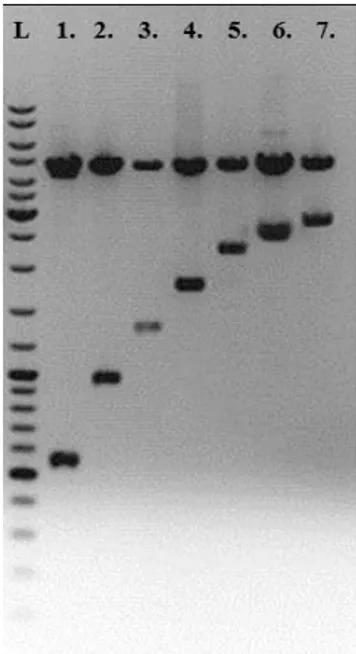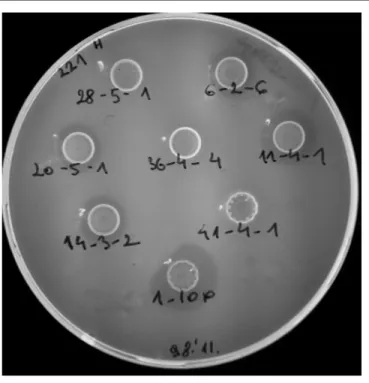___________________________
Corresponding author: Katarina Veljovi , Institute of Molecular Genetics and Genetic Engineering, University of Belgrade, Vojvode Stepe 444a, P.O. Box 23, 11010 Belgrade, Serbia,E-mail: lab6@imgge.bg.ac.rs
UDC 575 DOI: 10.2298/GENSR1302479V
Original scientific paper
MOLECULAR ANALYSIS OF ENTEROLYSIN A AND ENTL GENE CLUSTER FROM NATURAL ISOLATE ENTEROCOCCUSFAECALIS BGPT1-10P
Katarina VELJOVI *, Amarela TERZI -VIDOJEVI , Maja TOLINA KI, Milan KOJI and Ljubiša TOPISIROVI
Institute of Molecular Genetics and Genetic Engineering, University of Belgrade,Serbia
Veljovi K., A. Terzi -Vidojevi , M. Tolina ki, M. Koji and Lj. Topisirovi (2013): Molecular analysis of enterolysin a and entl gene cluster from natural isolate Enterococcus faecalis bgpt1-10p. Genetika, Vol 45, No. 2, 479-492.
Strain Enterococcus faecalis BGPT1-10P was isolated from artisanal semi-hard homemade cheese from Stara Planina, Serbia. Results showed that BGPT1-10P synthesized a heat labile bacteriocin with a broad spectrum of activity, including Listeria and Candida species. Further analysis revealed that synthesized bacteriocin is enterolysin A. Moreover, the entL gene encoding enterolysin A was found to be located on the chromosome. The entL gene was cloned and sequenced. Analysis of nucleotide sequence showed that the entL gene in natural isolate En. faecalis BGPT1-10P is identical to that of the entL gene described previously in En. faecalis LMG 2333. Within the cloned DNA fragment containing the entL gene, four ORFs were detected. One of them was identified as the scpE gene, which encodes a virulent factor staphopain peptidase. Functional analysis of the entL gene showed that the complete genetic information necessary for the synthesis of enterolysin A were directly linked solely to it. Strain BGPT1-10P also synthesized gelatinase and citolysin, and contained a set of virulent factors. In addition, BGPT1-10P carries the ermB and tetM genes conferring the resistance to erythromycin and tetracycline, respectively.
Key words: Enterococcus faecalis / enterolysin A / scpE gene / antibiotic resistance.
INTRODUCTION
Genus Enterococcus is a part of the natural intestinal microflora of humans and animals and is very important in the maintaining the balance of it (LEROY et al., 2003). Enterococci have exceptional ability to adapt to inhabit different ecological niches (GIRAFFA, 2003). The data
fermentation of food of plant and animal origin and synthesize bacteriocins with excellent antibacterial effect (FRANZet al., 1999). Enterococcal bacteriocins, so-called enterocins, are the subject of detailed study for many years (GÁLVEZ et al., 2007). Their diversity, ecological and practical importance in biopreservation of foods is the objects of investigation in recent years (FRANZ et al., 2007).
On the other hand, enterococci are regarded as indicators of undesirable contamination as well as the microorganisms, which can carry the pathogenic potentials (GIMNÉZ-PEREIRA, 2005). Enterococci are often involved in food spoilage and the spread of antibiotic resistance via the food chain (GIRAFFA, 2002). Detection of virulence factors and antibiotic resistance genes
with immune-compromising patients leads to the fact that enterococci may be the cause of many diseases (FRANZ et al., 2003). Fortunately, these characteristics are strain specific and are mostly found among clinical isolates of enterococci. However, studies performed in the recent decades indicated the presence of virulence factors in enterococci isolated from food.
In addition, the presence of the same virulence factor in clinical isolates of enterococci and in the strains isolated from food was confirmed by the PCR method (EATON and GASSON, 2001). Moreover, the research over last decade showed that enterococci present in the food could be reservoirs of antibiotic resistance genes (OGIER and SERROR, 2008). One of today's most pressing problems is the risk of vancomycin-resistant enterococci (VRE). Resistance to chloramphenicol, tetracycline and erythromycin was found in En. faecalis, isolated from dairy products. Often detection of antibiotic resistance in enterococci from dairy products is a result of mutations or the acquisition of new gene(s) as consequence of an efficient transfer of genes encoding the resistance among other bacteria and enterococci due to transposons and plasmids carrying those genes (TEUBERet al., 1999; HOLLENBECK and RICE, 2012).
The aim of this work was to characterise an enterocin-producing natural En. faecalis BGPT1-10P isolated from homemade cheese. The localization of the gene encoding enterolysin A and an analysis of the cloned DNA fragment carrying it was carried out. In addition, the presence of the genes encoding antibiotic resistance as well as virulence factors was also examined.
MATERIALS AND METHODS
Bacterial strains, media and growth conditions
The bacterial strains and plasmids used in this study are listed in Table 1. Enterococcus faecalis BGPT1-10P was isolated from semi-hard homemade cheese using standard microbiological procedures. Preliminary strain determination was done according to physiological tests, and ability of strain to perform the hydrolysis of esculin and form black areas on bile-esculin agar. Further taxonomic determination of BGPT1-10P was done by species-specific PCR for enterococci species (VALENZUELA et al., 2009). Enterococcal strains were grown at 30°C in M17 medium (Merck GmbH, Darmstadt, Germany) supplemented with 0.5% glucose (GM17). Escherichia coli DH5 (HANAHAN, 1983) was grown in Luria broth (LB) medium at 37°C (SAMBROOKet al., 1989). To each medium, agar (1.5% w/v; Torlak, Belgrade, Serbia) was added when used as a solid medium.
Detection and characterization of bacteriocin produced by En. faecalis BGPT1-10P
were incubated for 24 h at 30°C. A clear zone around the well, but not near the protease crystal, was taken as a positive signal for bacteriocin production. A preliminary characterization of the bacteriocin was performed, using an overnight culture supernatant, which was tested for stability to heat and pH. For heat sensitivity, 1 ml samples were heated from 40°C to 100°C with increase of 10°C for 15 min each. To test pH sensitivity, 1 ml aliquots of active supernatants were adjusted to different pH values (from 2 to 14) with 1 M NaOH or 1 M HCl. The activity of treated supernatant was explored by agar well diffusion assay.
Table 1. Bacterial strains and plasmids used in this study Bacterial strains,
plasmids Relevant characteristic(s) Source or reference
En. faecalis BGPT1-10P Natural isolate from soft homemade cheese,
Bac+ VELJOVIC et al., 2009
En. faecalis BGZLS10-27
Natural isolate from soft homemade cheese,
Bac− VELJOVIC et al., 2009
En. faecalis BG221 Natural isolate from soft homemade cheese VELJOVIC et al., 2009
E. coli DH5 F –,
∆lac, U169(Φ80 lacZ ∆M15), supE44,
hsdR17, recA1, gyrA96, endA1, thi–1, relA1 HANAHAN, 1983
pGEM-T Easy Ampr, lacZ, Promega, Madison, USA
pA13 Emr, lacZ, derivative of plasmid pA1, 4601 bp KOJICet al., 2010 Bac+ − production of bacteriocin Bac− − no bacteriocin prodaction
Molecular techniques
Molecular cloning techniques like ligation, PCR amplification and agarose gel DNA electrophoresis were carried out essentially as described previously(SAMBROOK et al., 1989). Digestion with restriction enzymes was conducted according to the supplier's instructions (Fermentas, Vilnius, Lithuania). Plasmids from E. coli were isolated using the QIAprep Spin Miniprep kit according to the manufacturer's recommendations (QIAGEN, Hilden, Germany). Plasmid DNA from enterococci was isolated using method for isolation of large plasmid described by O'SULLIVAN and KLAENHAMMER (1993). The DNA fragments from agarose gels were purified using QIAqick Gel extraction kit as described by the manufacturer (QIAGEN). E. coli DH5α competent cells were prepared using chemical treatment and transformed by heat shock transformation. Selection of transformants was performed by using antibiotic ampicillin (100µg/ml for E. coli) and erythromycin (5 µg/ml for enterococci or 250 µg/ml of for E. coli). En. faecalis BGZLS10-27 electrocompetent cells were prepared and transformed as previously described (SHEPARD and GILMORE, 1995) using Eppendorf Electroporator (Eppendorf, Hamburg,
Germany).
DNA sequencing and analysis
primers (Table 2). PCR amplicons were separated by electrophoresis on a 1% agarose gels and visualized by ethidium bromide staining under UV illuminator.
Table 2. Specific primers used for PCR amplification
Primer Sequence Annealing
temperature t°C Source or reference
Primers for enlA gene
EntlA3 5'-GGACAACAATTCGGGAACACT-3'
55°C NIGUTOVA et al., 2007. EntlA9 5'-GCCAAGTAAAGGTAGAATAAA-3'
Primers for inverse PCR
Ent1inv 5'-CAGTGTTCCCGAATTGTTGTCC-3'
50°C This study Ent2inv 5'-TTTATTCTACCTTTACTTGGC-3'
Primers for orf 2
P1FW 5'-GCTAAATATGGTCATGCG-3'
50°C This study P2RV 5'-CATCTAATGCTTCATGAG-3'
Primers for entL gene
P3FW 5'-CTGGTTGTTATTAATCTA-3'
50°C This study P4RV 5'-TTATACTCGTTCACCTCT-3'
Primers for orf 3
P5FW 5'-AGAAAATGACAGTAGGAT-3'
50°C This study P6RV 5'-GCAGAGCCTATAAGTATT-3'
Primers for orf 4
P7FW 5'-AACCGATTGGATGGAACC-3'
50°C This study P8RV 5'-ACTTCTGACATGCATGACT-3'
Primers for tetK gene
TETK-FW1 5'-TTATGGTGGTTGTAGCTAGAAA-3'
55°C GEVERSet al., 2003 TETK-RV1 5'-AAAGGGTTAGAAACTCTTGAAA-3'
Primers for tetL gene
TETL-FW3 5'-GTMGTTGCGCGCTATATTCC-3'*
55°C GEVERSet al., 2003 TETL-RV3 5'-GTGAAMGRWAGCCCACCTAA-3'*
Primers for RPP genes except otrA
RIBO2-FW 5'-GGMCAYRTGGATTTYWTIGC-3'*
„Touchdown” AMINOVet al., 2001 RIBO2-RV 5'-TCIGMIGGIGTRCTIRCIGGRC-3'*
Primers for ermA
ERMA-FW 5'-AAGCGGTAAACCCCTCTGA-3'
55°C STROMMENGERet al., 2003
ERMA-RV 5'-TTCCCAAATCCCTTCTCAAC-3'
Primers for ermB
ERMB-FW 5'-CATTTAACGACGAAACTGGC-3'
55°C JENSEN et al., 1999 ERMB-RV 5'-GGAACATCTGTGGTATGGCG-3'
Primers for ermC
ERMC-FW 5'-AATCGTCAATTCCTGCATGT-3'
55°C STROMMENGER et al., 2003
ERMC-RV 5'-TAATCGTGGAATACGGGTTTG-3'
Southern blot analyses
Total DNA from En. faecalis BGPT1-10Pwas isolated by the procedure described by HOPEWOOD et al. 1985. with slight modifications. Isolated DNA was digested by HindIII restriction endonuclease, separated by gel electrophoresis in 1% agarose and blotted to nylon membranes as described by MANIATISet al. (1982). Prehybridization and hybridization was done as described by the BOEHRINGER MANNHEIM manual for the DIG DNA labelling and detection kit (Roche Diagnostics GmbH, Mannheim, Germany). Membranes were probed with PCR-amplified entL structural gene labelled by incorporation of digoxigenin-11-dUTP (Roche Diagnostics GmbH) following the manufacturer’s instructions. Hybridization was carried out at 65°C.
Determination of the entL gene cluster flanking sequences
To determine the sequences upstream and downstream of the entL gene, inverse PCR was carried out with Ent1inv and Ent2inv primers (Table 2) using as template DNA of En. faecalis BGPT1-10P digested with HindIII restriction enzyme, precipitated with ethanol and resuspended in water. Obtained DNA fragments were ligated overnight at 16°C in 20 l reaction mixture. After ligation, the mixture is precipitated with ethanol and then used as template for PCR. The resulting purified PCR products were passed through a QIAquick PCR Purification KIT/250 (QIAGEN GmbH, Hilden, Germany), then cloned in pGEM-T Easy vector (Promega, Madison, USA). The fragment of 3.5 kb was sequenced in Macrogen's sequencing service (Seoul, Korea). Based on the obtained sequences, the corresponding primers were synthesized (Table 2) and used to recheck unknown surrounding sequences by inverse PCR.
The BLAST algorithm was used to determine the most related sequence relatives in the NCBI nucleotide sequence database (http://www.ncbi.nlm.nih.gov/BLAST). The DNA Strider program was used for open reading frame (ORF) prediction.
RESULTS
Characterization of Enterococcus faecalis BGPT1-10P
Strain Enterococcus faecalis BGPT1-10P isolated from semi-hard homemade cheese exhibited a broad spectrum of activity towards Gram-positive bacteria. BGPT1-10P inhibited among others the growth of Listeriamonocytogenes, L. innocua and Candida pseudotropicalis (VELJOVIC et al., 2009). Bacteriocin of the strain BGPT1-10P was heat labile losing an activity after incubation for 15 min at 60°C and above tested temperature, but not after incubation for the same time at 40°C or 50°C. Testing bacteriocin activities at different pH values showed that it retains activity in the pH range from four to 10.
Figure 1. Electrophoresis of DNA fragment after PCR amplification on 1% agarose gel. L. ″Gene RulerTM″100 bp DNA Ladder, 2. 1007 bp fragment of
entL gene after PCR reaction with EntlA3 and EntlA9 primers and chromosomal DNA from BGPT1-10P strain
Localization of structural entL genes in strain Enterococcus faecalis BGPT1-10P
To make a precise location of the entL gene, Southern hybridization was performed using chromosomal and plasmid DNA isolated from En. faecalis BGPT1-10P as described in Materials and methods. A hybridization signal was not detected with plasmid DNA. In contrast, a positive hybridization signal was obtained with 4.5 kb long HindIII fragment of chromosomal DNA, suggesting that the entL gene is located on the chromosome of the strain En. faecalis BGPT1-10P (Figure 2).
Figure 2. Southern blot hybridization of entL gene. L.
″Gene RulerTM
Analysis of the entL gene flanking sequences
Using circularized HindIII fragment of 4.5 kb as a template for the inverse-PCR with primers Ent1inv and Ent2inv, PCR amplification yielded a DNA fragment of 3.5 kb which was overlapped with 1kb long entL gene. It was found that the sequence of 4.5 kb contains four open reading frames (ORFs) in addition to entL gene. There are two hypothetical proteins (ORF1 and ORF2), a conserved domain protein (ORF3) and part of the scpE gene encoding staphopain peptidase. BLAST searching the NCBI database revealed that the partial amino acid sequence of staphopain peptidase from strain BGPT1-10P is the same as deposited for strains of Staphylococcus aureus species, as well as of several clinical En. faecalis strains (En. faecalis TX1302, Acc.No. AEBK01000059.1; En. faecalis TX1342, Acc.No. AEBJ01000044.1; En. faecalis TX4244, Acc.No. AEBH01000029.1 itc.).
The total size of the amplified and analyzed DNA sequence of En. faecalis BGPT1-10P was 5,156 bp (Figure 3). The sequence was submitted into the EMBO database, GenBank, Acc.No. HE585879.1.
Figure 3.ORFs arrangement and orientation on 5,156 bp DNA sequence, with bacteriocin activity of cloned
and expressed fragments in pA13 vector and position of all primers used in PCR reaction for obtaining fragments carrying specific ORFs or their combination.
Functional analysis of the identified ORFs
To perform the functional analysis of the identified ORFs a set of constructs were made by using PCR and appropriate primers (Table 2). This analysis was also used to see whether the entL gene solely could encode a synthesis of enterolysin A. Therefore, the genes orf2, entL, orf3 and scpE were amplified separately or in combinations (orf2 + entL; entL + orf3 and orf2 + entL + orf3), and cloned into pGemT-Easy vector. To test the functionality of these genes a re-cloning of EcoRI fragments from pGemT-Easy vector into the pA13 vector that has ability to replicate in enterococci was made. Obtained constructs designated as k6 (carrying solely the entL gene), k11 (entL + orf3), k14 (orf2 + entL), k20 (orf2 + entL + orf3), k28 (orf2), k36 (orf3), k20 (orf2, entL and orf3), and k41 (orf4) were digested with EcoRI to confirm that they are carrying the expected fragments (Figure 4).
Figure 4.EcoRI digestion of all constructs after cloning in pA13 vector; L - ″Gene RulerTM″100 bp DNA Ladder, 1. k28 (orf2), 2. k36 (orf3), 3. k6 (entL), 4. k41 (orf4), 5. k11 (entL and orf3), 6. k14 (orf2 and entL), 7. k20 (orf1, entL and orf3).
Figure 5.Antimicrobial activity of supernatants from transformants: 28-5-1, 6-2-6, 20-5-1, 36-4-4, 11-1-4, 14-3-2, 41-4-1 and BGPT1-10P as control strain, with BG221 as the indicator strain.
Analysis of nucleotide sequences
Detection of antibiotic resistance genes
Strain BGPT1-10P is resistant to erythromycin (MIC≥4mg/L) and tetracycline (MIC≥ 16 mg/L). PCR method was used to see whether the phenotypic resistance to erythromycin and tetracycline is associated with the presence of known genes. PCR analysis revealed the presence of ermB gene product of 425 bp. Obtained PCR fragments were sequenced and computer-assisted alignment of nucleotide sequences with BLAST program showed 97% identity to the ermB gene encoding protein ErmB conferring a resistance to erythromycin. In addition, PCR analysis revealed the presence of tetM gene that encode tetracycline resistance via a ribosome protection protein mechanism.
DISCUSSION
In this paper, we analysed the strain En. faecalis BGPT1-10P isolated from home-made cheese, which is made without the addition of starter cultures in milk. It is shown that this strain synthesized bacteriocin with a broad spectrum of activity, including Listeria and Candida species and some enterococci and lactococci species. Strain BGPT1-10P does not show activity against tested lactobacilli as well as the pathogenic species of E. coli and S. aureus (VELJOVIC et al., 2009).
It has been shown that strain BGPT1-10P synthesize a heat labile enterocin and also contains the gene encoding enterolysin A (entL). The entL gene in BGPT1-10P is located on the chromosome, on the 4.5 kb HindIII fragment. It has been shown previously that genes encoding some bacteriocins like helveticin J (JOERGER and KLAENHAMMER, 1990) and enterocin AS-48RJ
(ABRIOUEL et al., 2005) are localized on chromosome. The analysis of the entL gene flanking sequences of natural isolates BGPT1-10P, shown a unique sequence that contained four potential genes (orf1, orf2, entL and orf3), and the gene for staphopain peptidase (orf4). Similar order sequences of the genes were found in clinical enterococcal genomes, whose sequences are deposited in the database. As regards the homology of genes, it was shown that is a hypothetical protein ORF2 of the strain BGPT1-10P, differs from the same protein from En. faecalis clinical strains JH1, D6 and others. The percentage of identity ORF2 was 75% with hypothetical protein En. faecalis strains JH1 or 54% identity with hypothetical protein originating from the strain Lb. casei BL23. At the same time, and the nucleotide sequence of orf1 gene shows 89% homology with genes localized on plasmid pLG2 strain originating from En. faecalis.
Orf4 gene encodes a protein, which is 100% identical to staphopain peptidase C47, which was initially characterized for the species S. aureus (ARVIDSONet al., 1973). According to CHEUNG and colleagues (1997) suggested that this enzyme is designated as a virulent factor, and it's present in several clinical isolates of En. faecalis species deposited in the database. In this paper, orf4 gene was identified as scpE staphopain peptidase gene of natural isolates BGPT1-10P. This data suggests a strong similarity of enterococci and staphylococci species, and their common origin. At the same time, points to the fact that enterococci have a strong ability to communicate with other bacteria, and efficient transfer of genetic elements, and thus explains the fact that they possess genetic elements specific to pathogenic species. Functional analysis showed that solely the entL gene encodes the complete genetic information, necessary for the synthesis and activity of enterolysin A.
several independent events of gene transfer or gene transfer combined with subsequent genetic rearrangements.
Based on data from the literature it is known that different groups of independent scientists characterized the same bacteriocin (SÁNCHEZ et al., 2007; DE KWAADSTENIET et al., 2006). These results showed that the same bacteriocin is found in different species, which are not only distant in terms of classification, but also inhabit very different habitats. Strain BGPT1-10P seems to be identical to En. faecalis strain DPC5280, which was isolated from Irish raw milk (HICKEYet al., 2003). Both strains synthesized enterolysin A, citolysin without beta-hemolytic activity, gelatinase and both strains showed good antimicrobial activity, acting on a number of different bacteria. In addition, both strains are rich in a variety of virulence determinants and resistant to many antibiotics (HICKEYet al., 2003; VALENZUELAet al., 2009). It is obvious that the effect of gene transfer was a very large, which allows for strains that are temporally and spatially distant become similar, and at the same time may explain why some strains are rich in variety of virulence factors and resistant to many antibiotics. Since the strain BGPT1-10P are natural isolate, successful gene transfer may explain why this strain is full of virulent factors. In addition, BGPT1-10P is resistant to tetracycline and erythromycin (VALENZUELA et al., 2009). These antibiotics have wide application in humans and in animals. In this work, we determined the molecular basis of this resistance. The BGPT1-10P carries the ermB gene responsible for resistance to erythromycin and tetM gene responsible for tetracycline resistance.
Thanks to the great diversity of enterococci strains, and their possessing of different functional characteristics, it is necessary to analyse each individual strain, prior to its use in food or medicine.
ACKNOWLEDGEMENT
The Ministry of Education, Science and Technological Development, Republic of Serbia (Grant No. 173019) supported this work.
Received March 20th, 2013
Accepted July 10th, 2013
REFERENCES
ABRIOUEL, H, R. LUCAS, N. BEN OMAR, E. VALVIDI, M. MAQUEDA,M. M. CA AMERO, A. GALVEZ (2005): Enterocin AS–48RJ: a variant of enterocin AS–48 chromosomally encoded by Enterococcus faecium RJ16 isolated from food. Syst. Appl. Microbiol. 28: 383–397.
AMINOV, R. I, N. GARRIGUES–JEANJEAN, R. I. MACKIE (2001): Molecular ecology of tetracycline resistance: development and validation of primers for detection of tetracycline resistance genes encoding ribosomal protection proteins. Appl. Environ. Microbiol. 67: 22–32.
ARVIDSON, S., T. HOLME, B. LINDHOLM (1973): Studies on extracellular proteolytic enzymes from Staphylococcus aureus
I. Purification and characterization of one neutral and one alkaline protease. Biochim. Biophys. Acta. 302:
135–48.
CHEUNG, A. L., K. EBERHARDT, J. H. HEINRICHS (1997): Regulation of protein A synthesis by the sar and agr loci of Staphylococcus aureus. Infect. Immun. 65:2243–2249.
EATON, J. T, J. M. GASON (2001): Molecular screening of Enterococcus virulence determinants and potential for genetic
exchange between food and medical isolates. Appl. Environ. Microbiol. 67: 1628–1635.
FRANZ, C. M. A. P., M. J. VAN BELKUM, W. H. HOLZAPFEL, H. ABRIOUEL, A. GÁLVEZ (2007): Diversity of enterococcal bacteriocins and their grouping in a new classification scheme. FEMS Microbiol. Rev. 31: 293–310.
FRANZ, C. M. A. P., M. E. STILES, K. H. SCHLEIFER, W. H. HOLZAPFEL, (2003): Enterococci in foods–a conundrum for food safety.Int. J Food Microbiol. 88: 105–122.
FRANZ, C. M. A. P., W. H. HOLZAPFEL, M. E. STILES (1999): Enterococci at the crossroads of food safety? Int. J. Food Microbiol. 47: 1 –24.
GÁLVEZ, A., H. ABRIOUEL, R. L. LÓPEZ, N. BEN OMAR (2007): Bacteriocin-based strategies for food biopreservation. Int. J. Food Microbiol. 120: 51–70.
GEVERS, D., M. DANIELSEN, G. HUYS, J. SWINGS (2003): Molecular characterization of tet(M) genes in Lactobacillus
isolates from different types of fermented dry sausage. Appl. Environ. Microbiol. 69:1270-1275.
GIMÉNEZ–PEREIRA, M. L. (2005): Enterococci in milk products. PhD thesis, Massey University Palmerston North, New Zealand.
GIRAFFA, G. (2003): Functionality of enterococci in dairy products. Int. J. Food Microbiol. 88: 215–222. GIRAFFA, G. (2002): Enterococci from foods. FEMS Microbiol. Rev. 744: 1–9.
HANAHAN, D. (1983): Studies of transformation of Escherichia coli with plasmids. J. Mol. Biol. 166: 557-580.
HARRIS, L. J., M. A. DAESCHEL, M. E. STILES, T. R. KLAENHAMMER (1989): Antimicrobial activity of lactic acid bacteria against Listeria monocytogenes. J. Food Prot. 52: 384–387.
HICKEY, R. M., D. P. TWOMEY, R. P. ROSS, C. HILL (2003): Production of enterolysin A by a raw milk enterococcal isolate exhibiting multiple virulence factors. Microbiology 149: 655–664.
HOLLENBECK B, L. RICE (2012) Intrinsic and acquired resistance mechanisms in Enterococcus. Virulence 3: 421–569.
HOPWOOD, D. A., J. M. BIBB, K. F. CHATER, T. KIESER, C. J. BRUTON, H. M., H. M. KIESER, K. M. LYDIATE, C. P. SMITH, J. M.
WARD, H. SCHREMPF (1985): Genetic manipulation of Streptomyces, a laboratory manual. Norwich, UK, The John Innes Foundation.
JENSEN, L. B., N. FRIMODT–MOLLER, F. M. ARESTRUP (1999): Presence of erm gene classes in Gram–positive bacteria of
animal and human origin in Denmark. FEMS Microbiol. Lett. 170: 151–158.
JOERGER, M. C, T. R. KLAENHAMMER (1990): Cloning, expression, and nucleotide sequence analysis of the Lactobacillus helveticus 481 gene encoding the bacteriocin helveticin J. J. Microbiol. 172: 6339–6347.
KOJIC, M., J. LOZO, B. JOVCIC, I. STRAHINIC, D. FIRA, L. TOPISIROVIC (2010): Construction of a new shuttle vector and its use for cloning and expression of two plasmid–encoded bacteriocins from Lactobacillus paracasei subsp.
paracasei BGSJ2–8. Int. J. Food Microbiol. 140:117–124.
LEROY, F., M. R. FOULQUIE MORENO, L. DE VUYST (2003): Enterococcus faecium RZS C5, an interesting bacteriocin producer to be used as a co–culture in food fermentation. Int. J. Food Microbiol. 88: 235–240.
MANIATIS, T., E. F. FRITSCH, J. SAMBROOK (1982): Molecular cloning: a laboratory manual. Cold Spring Harbor Laboratory Press, Cold Spring Harbor, N. Y.
NIGUTOVA, K., M. MOROVSKY, P. PRISTAS, R. M. TEATHER, H. HOLO, P. JAVORSKY (2007): Production of enterolysin A by rumen Enterococcus faecalis strain and occurrence of entL homologues among ruminal Gram-positive cocci.
J. Appl. Microbiol. 102: 563-569.
NILSEN, T., I. F. NES, H. HOLO (2003): Enterolysin A, a cell wall–degrading bacteriocin from Enterococcus faecalis LMG
2333. Appl. Environ. Microbiol. 69: 2975–2984.
OGIER, J. C. P. SERROR (2008): Safety assessment of dairy microorganisms: The Enterococcus genus. Int. J. Food Microbiol. 126: 291–301.
O'SULLIVAN, D. J, T. R. KLAENHAMMER (1993): Rapid mini-prep isolation of high-quality plasmid DNA from Lactococcus
SAMBROOK, J., E. F. FRITSCH, T. MANIATIS (1989): Molecular cloning: a laboratory manual, 2nd ed. Cold Spring Harbor Laboratory Press, Cold Spring Harbor, N. Y.
SÁNCHEZ, J., D. B. DIEP, C. HERRANZ, I. F. NES, L. M. CINITAS, P. E. HERNÁNDEZ (2007): Amino acid and nucleotide sequence, adjacent genes, and heterologous expression of hiracin JM79, a sec-dependent bacteriocin produced by Enterococcus hirae DCH5, isolated from Mallard ducks (Anas platyrhynchos). FEMS Microbiol. Lett.
270: 227-236.
SHEPARD, B. D, M. S. GILMORE (1995): Electroporation and efficient transformation of Enterococcus faecalis grown in high concentrations of glycine. Methods Mol. Biol. 47:217–226.
STROMMENGER, B., C. KETTLITZ, G. WERNER, W. WITTE (2003): Multiplex PCR assay for simultaneous detection of nine clinically relevant antibiotic resistance genes in Staphylococcus aureus. J. Clin. Microbiol. 41: 4089–4094.
TEUBER, M., L. MEILE, F. SCHWARZ (1999): Acquired antibiotic resistance in lactic acid bacteria from food. Antonie Van Leeuwenhoek, 76: 115–137.
VALENZUELA, A. S., N. BEN OMAR, H. ABRIOUEL, R. L. LÓPEZ, K. VELJOVIC, M. M. CA AMERO, M. KOJIC, L. TOPISIROVIC, A.
GÁLVEZ (2009): Virulence factors, antibiotic resistance, and bacteriocins in enterococci from artisan foods of animal origin. Food Control 20: 381–385.
VELJOVIC, K., D. FIRA, A. TERZIC–VIDOJEVIC, H. ABRIOUEL, A. GALVEZ, L. TOPISIROVIC (2009): Evaluation of
antimicrobial and proteolytic activity of enterococci isolated from fermented products. Eur. Food Res. Tech.
MOLEKULARNA ANALIZA ENTEROLIZINA A I ENTL GENSKOG KLASTERA PRIRODNOG IZOLATA Enterococcusfaecalis BGPT1-10P
Katarina VELJOVI *, Amarela TERZI -VIDOJEVI , Maja TOLINA KI, Milan KOJI and Ljubiša TOPISIROVI
Institut za molekularnu genetiku i geneti ko inženjerstvo, Univerzitet u Beogradu, Beograd, Srbija
Izvod
Soj Enterococcus faecalis BGPT1-10P je izolovan iz doma eg polutvrdog sira, poreklom sa Stare Planine. Rezultati pokazuju da soj BGPT1-10P sintetiše termolabilan bakteriocin, enterolizin A, sa širokim spektrom delovanja, uklju uju i patogene bakterije roda Listeria i Candida. EntL gen, odgovoran za sintezu ovog bakteriocina, je hromozomalno lokalizovan. Analiza nukleotidne sekvence entL gena kod prirodnog izolata En. faecalis BGPT1-10P je identi ana sa entL genom soja En. faecalis LMG 2333, koji je prethodno okarakterisan. Pokazana je jedinstvena sekvenca entL gena i njegove okoline, koju ine orf1, orf2 i orf3 geni, kao i scpE gen. Prvi put je kod prirodnog izolata okarakterisan scpE gen, koji kodira virulentni faktor stafopain peptidazu. Funkcionalna analiza entL gena je pokazala da je kompletna geneti ka informacija, neophodna za sintezu i aktivnost enterolizina A, sadržana u entL genu. Soj BGPT1-10P osim enterolizina, sintetiše i želatinazu i citolizin i sadrži set razli itih virulentnih faktora. Pored toga, BGPT1-10P nosi ermB i tetM gene, odgovorne za rezistenciju na eritromicin i tetraciklin.
Primljeno 20. III 2013.
